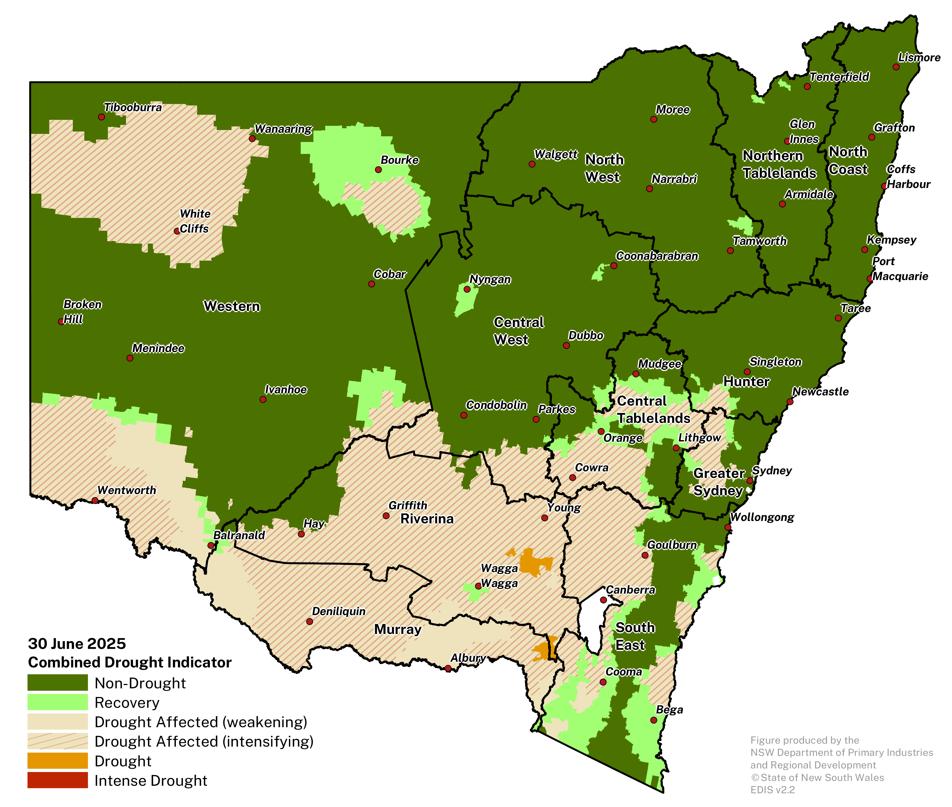June 2025
NSW summary
Overview
Contrasting seasonal conditions continue across NSW, with generally wet conditions in the north and drier conditions in the south and far west.
- At the end of June 2025, 70% of the state is in the Non-Drought or Recovery categories of the long-term drought indicator (NSW Combined Drought Indicator).
- Official rainfall observations for June were below average for much of coastal NSW, and for inland parts of the northern and central tablelands, the Hunter and western NSW.
- Falls between 25-100mm were observed in the drought affected regions in the Riverina and Murray, with some higher isolated totals reported, with above 100mm recorded in some areas in the east.
- An East Coast Low at the end of June to early July brought heavy rainfall and strong winds to parts of eastern NSW. Rainfall was widespread, with totals of up to and above 200mm at some coastal locations. Further inland, rainfall totals of 10 to 25mm were recorded.
Follow-up rainfall in June welcome for many drought-affected areas.
- Follow-up rainfall throughout June was timely and welcome across many areas in the Murray, Riverina, southern Tablelands and parts of Western NSW which has provided both cropping and mixed farming operations with a more optimistic outlook.
- Crop producers are optimistic as there was sufficient rain in May-June to aid germination and the initial establishment of winter crops.
- Livestock producers continue to experience and manage drought conditions and on-ground fodder shortages continue. Cold temperatures and frosts are limiting pasture growth, and potential recovery will not occur until warmer temperatures return in Spring.
Regional Insights
Positive production outlook continues for much of northern inland NSW.
- Despite a drier June, with many areas receiving below average rainfall, the production outlook remains strong for northern winter cropping production areas, with good germination and establishment of crops accessing stored soil moisture.
- The ongoing wet conditions remain challenging for some agricultural industries, particularly for producers on the Mid-North Coast impacted by recent flooding.
Emerging drought in far west NSW.
- Parts of far western NSW are managing an intense 6-9 month rainfall deficit.
- The rainfall deficit has not triggered the NSW-CDI in some parts of the region, but local reports indicate this is a moderate to severe drought event.
- Farm dam water levels are below 20% of capacity across most of the far west and below normal plant condition is evident in remote sensing information.
- The drought forecast indicates that much of the Western LLS region will likely be in the Drought Affected category of the NSW CDI in the coming months.
- Conditions continue to decline in the White Cliffs region and to the south of Bourke as a result of longer-term rainfall deficits in these areas.
Producers are carefully managing variable conditions in both livestock and cropping enterprises. More detail is available for each LLS region in the regional breakdown section of this Update.

Seasonal Outlook
The seasonal climate outlook issued by the Bureau of Meteorology is for a above median rainfall and warm temperatures as the most likely outcome for much of NSW in the July to September forecast period.
- There is a 45% to 80% chance of rainfall exceeding the historical median across NSW for the reporting period, depending on location.
- The temperature outlook indicates the likelihood of above median minimum temperatures for NSW for the reporting period is moderate to high (45% to above 80% chance). The chance of exceeding median maximum temperatures for NSW is between 55% to above 80% depending on location.
- The current ENSO value is -0.01°C (as of 29 June 2015) and the 30-day Southern Oscillation Index is currently +11.2 (as of 28 June 2025). The Indian Ocean Dipole (IOD) is currently 0.0°C (as of 29 June 2025).
DPIRD Drought Forecast
The most likely outcome is for drought conditions to improve in parts southern NSW, and further expand across western and central NSW.
- Despite an optimistic rainfall outlook, drought conditions are likely to expand further into western and central NSW in areas that have been experiencing longer-term rainfall deficits and where rainfall is unlikely to be sufficient to positively impact the underlying NSW-CDI indicators.
- The intensity of conditions is likely to ease in parts of the South East, Riverina and Murray LLS regions.
- Forecast ensemble agreement and historical accuracy vary by region. In this forecast period regions of moderate to low agreement correspond to those that are forecast to have intensifying drought conditions.
- Past skill for this forecast period is low to moderate for most of NSW.